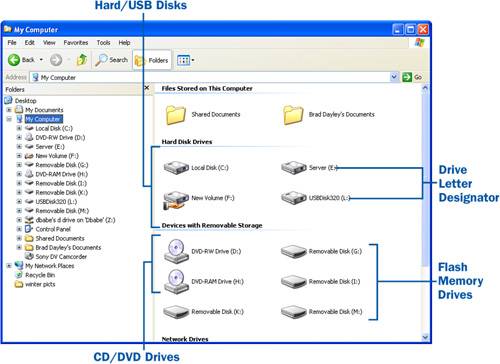About Storage Media
| Storage media are devices you can use to store your computer files. While you are using Easy Media Creator, you need to use storage media for various tasks such as saving files you import into the computer, saving projects you are working on, backing up your data, and creating portable copies of your files. Storage media devices are given a letter designator on your computer that allows you to identify them. For instance, if you start Windows Explorer and look under My Computer, you should at least see one drive with the designator C:. The following sections discuss the different types of storage media that you will be using as you import files and create projects in the Easy Media Creator suite. Hard DrivesHard drives are the main type of storage for your computers. Almost all computers have at least one internal hard drive with the C: letter designator. You can add additional hard drives by adding an internal hard drive inside your computer case. There are also external hard drives that plug into the computer using a USB or FireWire port. As you add additional drives they are given their own drive letter designator. Your computer might also have a partitioned hard drive that is segmented to store different types of data, such as applications and files, on different sections of the hard drive. If you have a hard drive with partitions, it appears in My Computer with two drive-letter designators, such as C: or D:. When you can, use your hard drives to store the files with which you are working. The hard drive is much faster than any other storage media. Hard drives also can contain much more data, upwards of 500GB per disk. CD-RCD-R media are recordable CDs that allow you to write files onto them. The CD-burner drive, used to write files to disc, has its own drive letter designator, just like a hard drive. You use this designator to identify the drive when burning data and to access the data on discs that have been written. You can use CD-Rs to create music discs, to make portable copies of your files to take to other locations, or to back up your PC. However, a CD-R disc only holds about 700MB of data, so space is limited. There are also CD-RW discs that allow you to erase and then rewrite files onto them. CD-RW discs are more expensive than the CD-Rs and there are a limited number of times they can be rewritten before they must be replaced. Also, if you create an audio CD using a CD-RW disc, many CD players won't recognize the disc. CD-RW discs are also written more slowly than CD-Rs. For those reasons, CD-Rs are still more popular. DVD±RDVD±R media are recordable DVDs similar to the CD-R media. The biggest difference is that a DVD±R disc contains about 4.7GB of space. If you have large amounts of data you need to put on a disc, this is the best choice. You also use the DVD±R media to create DVDs that can be played in a standard player. Recordable DVD media comes in two flavors: DVD-R and DVD+R. The only difference between + and - discs is that different manufacturers own the patents on them. Otherwise, they are identical, and if you bought your DVD burner in the past three years, it will burn both types of discs. Both DVD+R and DVD-R discs play in most, but not all, DVD players. If you burn a DVD that your player does not recognize, try another brand. Several companies have also started manufacturing DVD±R DL discs. The DL stands for dual-layer. DL discs can store 8.5GB of data because they have two layers of storage on the recordable side of the disc. Creator can handle DL recording, but many burners cannot record these discs. The discs are expensive, the technology is still fairly new, and many players won't play DL discs, so you're better off sticking with regular 4.7GB DVD±R. There are also rewritable DVD discs called DVD±RW. They have the same advantages and disadvantages of CD-RWs. Unless you plan on doing a lot of erasing and rewriting, DVD±R is a more reliable choice. USB DisksUSB disks are similar to the external hard drives mentioned earlier. They connect to the computer using the USB port. The big difference is that they are much smaller, about the size of a finger, and only hold up to 1 or 2GB of data. When you connect a USB disk to the computer, it is given its own drive letter designator to access it. Flash MemoryFlash memory are small cards that act like tiny hard drives. They are called flash memory cards because their memory can quickly be erased and replaced by new data. These cards are used to store data for numerous electronic devices, such as pictures taken by digital cameras. A card reader must be used to read flash memory cards on the computer. Some computers come with built-in card readers, or you might need an external card reader that connects to the computer using the USB port. There are seven types of flash memory media cards. The most popular are Secure Digital (SD), MemoryStick, and Compact Flash. They vary in size and appearance. However, many card readers now are able to read most or all of them. To use a flash memory card, simply insert it into the card reader and a new drive letter for it is added. You can then access the card just like a hard drive. Hard drive variations.  |
EAN: 2147483647
Pages: 171